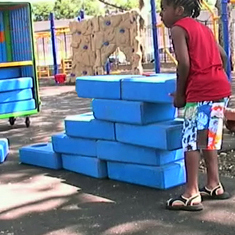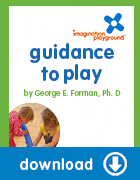Structures with repeated intervals require a form of mathematical thinking: “If I continue repeating this same interval the structure will look like what I expect.”

Stacks result from the simple act of repeatedly placing a new block in the same place. The structure grows and the young children love to see the height.

This girl has made a tiered wall using the more stable method of off-setting each block on a top row to cover the joint between the two blocks below. To do this she has to resist the usual strategy of stacking blocks in adjacent towers.
What It Means
In essence, the child is thinking about the way a standard unit can help them predict how something will look if that unit is consistently used. The tiered wall is interesting because the units on each row above are deliberately moved a half-unit over, instead of just placing one block exactly on top of the one below. You could call this principle the N + 1⁄2 rule. The domino row uses a principle of causality called “propagation.” The first block causes the second one to fall, and then the block that was hit becomes the block that hits the third. In this manner an effect is propagated down the line. Each effect becomes a cause as well, an advanced and rather neat concept.
2-4 Year Olds
The repeated intervals for the twos and threes are more likely to come through actions, like taking many long strides, rather than through setting up the blocks with intervals. These actions, too, are a preliminary form of thinking about intervals.
4-7 Year Olds
Young children may repeat the placement of same-size blocks, such as making a stack or row, but will seldom create multiple intervals by adjusting the amount of vacant space between blocks. The vacant space becomes the focus for older children, as you see in the photographs. In some cases the repeated gaps serve only to decorate an otherwise conventional structure.
7-10 Year Olds
The more advanced children will figure out reasons to make repeated gaps the same size, such as starting gates for a foot race or turrets on a castle from which pretend sentries can stand and shoot their arrows. While this merger of form and function may be advanced, the purely decorative patterns have a mathematical elegance to be both admired and understood as important to intellectual development.
This material is adapted from the publication “Imagination Playground’s Guidance to Play” by George E. Forman, PhD, Emeritus Professor, University of Massachusetts (Amherst) and President of Videatives, Inc.
Dr. Forman has over 33 years of experience in university teaching, cognitive research, multimedia design and educational consulting in the area of early childhood learning and development.
“Guidance to Play” covers 20 topics that help illustrate the significance in what children are doing as they play as well as concrete actions Play Associates can take to facilitate positive behaviors.



